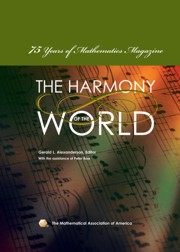Book contents
- Frontmatter
- Introduction
- Contents
- A Brief History of Mathematics Magazine
- Part I The First Fifteen Years
- Part II The 1940s
- Part III The 1950s
- Part IV The 1960s
- Part V The 1970s
- Trigonometric Identities
- A Property of 70
- Hamilton's Discovery of Quaternions
- Geometric Extremum Problems
- Pólya's Enumeration Theorem by Example
- Logic from A to G
- Tiling the Plane with Congruent Pentagons
- Unstable Polyhedral Structures
- Part VI The 1980s
- Briefly Noted
- The Problem Section
- Index
- About the Editors
Geometric Extremum Problems
from Part V - The 1970s
- Frontmatter
- Introduction
- Contents
- A Brief History of Mathematics Magazine
- Part I The First Fifteen Years
- Part II The 1940s
- Part III The 1950s
- Part IV The 1960s
- Part V The 1970s
- Trigonometric Identities
- A Property of 70
- Hamilton's Discovery of Quaternions
- Geometric Extremum Problems
- Pólya's Enumeration Theorem by Example
- Logic from A to G
- Tiling the Plane with Congruent Pentagons
- Unstable Polyhedral Structures
- Part VI The 1980s
- Briefly Noted
- The Problem Section
- Index
- About the Editors
Summary
Editors' Note: Gulbank D. Chakerian is Professor Emeritus of Mathematics at the University of California, Davis, where he joined the faculty after completing his PhD at Berkeley and after a short stay at the California Institute of Technology. His research is in geometric inequalities and convex sets.
Lester Henry Lange, a student of George Pólya's at Stanford, was for many years on the mathematics faculty at San Jose State University, where he was later Dean of the College of Science. Since retirement he has been active in the Moss Landing Marine Laboratories of the California State University system.
Both authors have received awards for expository writing from the MAA, Chakerian a Lester R. Ford Award for this paper in 1971, plus a Carl B. Allendoerfer Award in 1991 and a George Pólya Award in 1981; Lange the Ford Award for this paper and a Pólya Award in 1993. Lange is known for a popular text, Linear Algebra (Wiley, 1968). Recently Chakerian contributed to a collection, Mathematical Adventures for Students and Amateurs (MAA, 2004).
Introduction
A standard exercise for calculus classes reads: Given a triangle of altitude a and base b, find the dimensions of the rectangle of maximum area which can be inscribed in this triangle with one side along the base.
It at least broadens a student's perspective if he occasionally sees an alternate solution of such a problem avoiding the calculus.
- Type
- Chapter
- Information
- Harmony of the World75 Years of Mathematics Magazine, pp. 151 - 160Publisher: Mathematical Association of AmericaPrint publication year: 2007



